Holy Name Catholic Church (Demolished)
Introduction
Text-to-speech Audio
Though only an empty lot remains of the once-prominent church, Holy Name Catholic Church was a major fixture of the area for many decades. Founded in January of 1886, the church originally served a mixture of white- and blue-collar white families. In the early 1900s, Black families began to move into the area, creating tension with white residents and changing the demographic of the congregation. In 1948, after the previous restrictive housing covenants were ruled illegal, more African-American families moved into the area as the white residents drained out to the suburbs. By the 1960s, the congregation was mostly African-American. The church played an important role in the development of the April 1968 riots that spread throughout Kansas City following the assassination of Dr. Martin Luther King, Jr. Unfortunately, the building was demolished in 2011, after sitting empty for several years, though elements of the stone were incorporated into to façade of Saint Peter's Parish. Despite its ignominious end, the history of Holy Name Catholic Church offers valuable insight into the history of the area, as well as providing an important dimension of the unrest that shook Kansas City in April of 1968.
Images
Picture of Father Gibbons pointing to broken window from the 1968 riots after the death of Rev. Dr. Martin Luther King, Jr. Taken 1968/
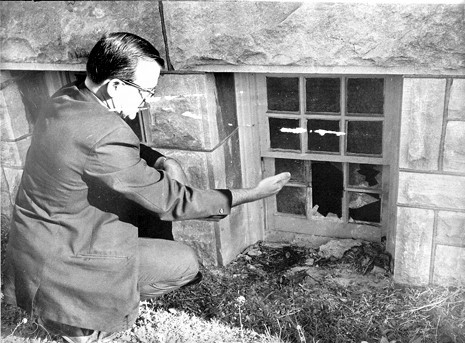
Picture looking north inside Holy Name Catholic Church. Picture taken November, 2002.
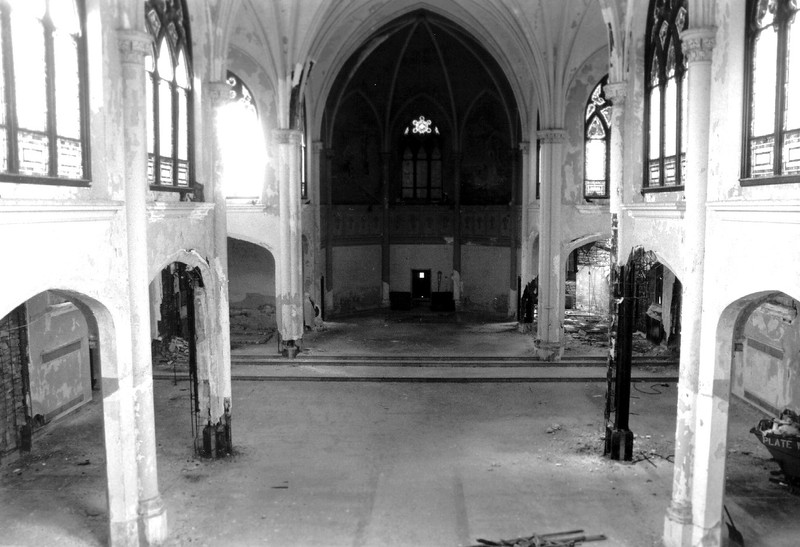
Picture looking south inside Holy Name Catholic Church. Picture taken November, 2002.
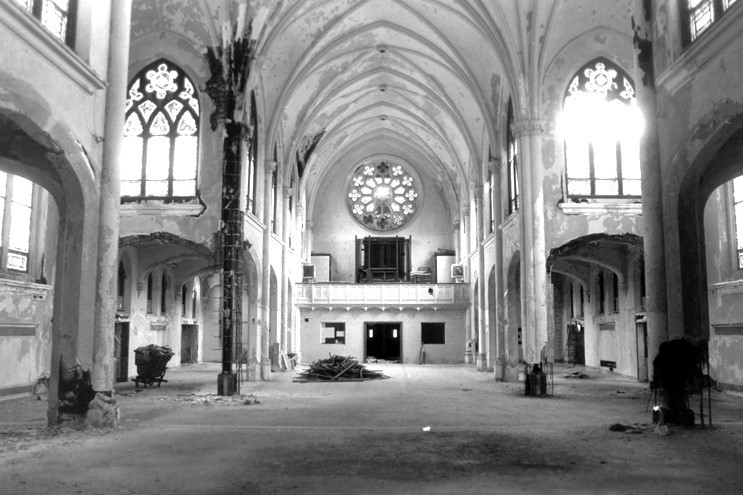
Picture of Holy Name Catholic Church, looking northwest. Picture taken November, 2002
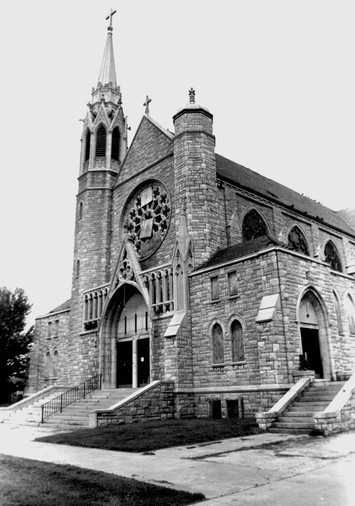
Picture of Holy Name Catholic Church, looking north (south side of the building), with East 23rd Street visible in the foreground . Picture taken November, 2002
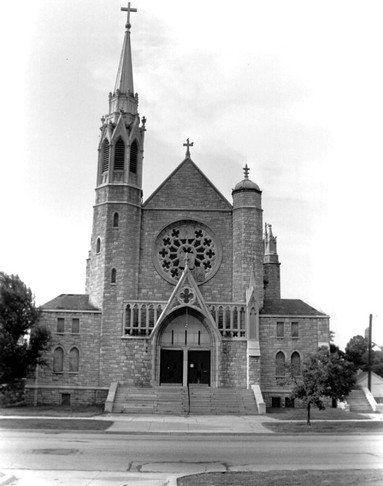
Picture of Holy Name Catholic Church, looking east (west side of the building), with East 23rd Street visible in the foreground . Picture taken November, 2002
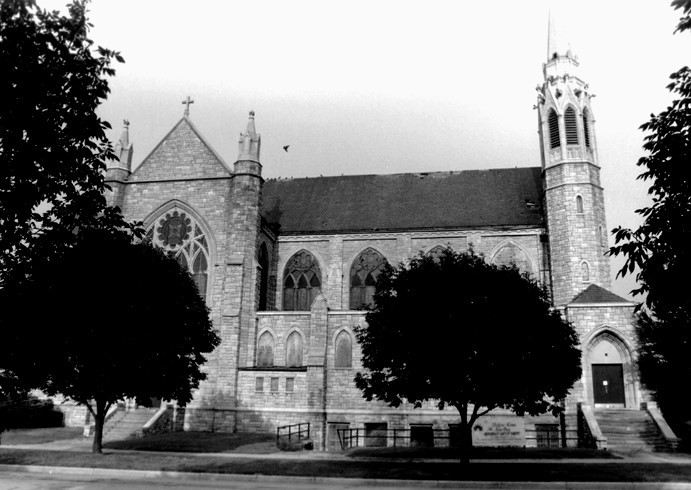
Backstory and Context
Text-to-speech Audio
In 1907, the Dominican Fathers purchased the site that would become Holy Name Catholic Church with the intent to build a cathedral-style church that could seat approximately a thousand congregants, as well as a school. Working with architecture firm Wight & Wight (the firm behind City Hall and the original Courthouse), the basement sections of the construction were completed in 1911. At this point, funding for the project dried up, leaving construction to cease for the next 13 years. In 1924, Wichita-based Brinkman & Hagen were brought on to complete the building under a new design. The occupancy was lowered to 750, and the planned transepts at one end of the structure were removed from the plans to save money. The building was completed and dedicated in June of 1928, with a final cost estimated as being $175,000. There were sixteen large stained glass windows and a circular rose window at one end. According to one source, the sacristy of the building was based on that of a cathedral in Rouen, France. (Shields) Joanie Shields writes that numerous organizations and community amenities were facilitated and hosted by the church over the years. These included a Boy Scout troop in 1929 and a credit union in 1941, as well as a bowling alley in the basement that was open from 1949 to 1959. Additionally, the staff of the church collaborated with prominent Black-run radio station KPRS to begin a program called the Radio Rosary in 1953.
Originally, the congregation consisted mostly of white working-class people. According to National Register of Historic Places documents, this began to change around 1911, when "several African American families moved into the area around 25th and Montgall." These families were met with a series of death threats and six attempted bombings, but remained in the area, with more African-American families moving to the area after the 1948 Shelly v. Kraemer decision outlawed the restrictive housing covenants that had previously kept Black home-buyers out of the area. In May 1951, the parish was combined with the majority-Black Holy Spirit Parish, citing financial concerns from the Archdiocese, though this move exacerbated both social tension in the area and financial tension on the church. Though the services were integrated, some amenities, such as the bowling alley, remained white-only, though the revenue still supported the church.
The most prominent event to take place at Holy Name Catholic Church happened on Tuesday, April 9th, 1968. On that day, many school districts around the nation were closed in observance of the funeral of Dr. Martin Luther King, Jr, who had been shot four days earlier. The districts of Kansas City, MO, however, had chosen to remain open for reasons that have been lost to history. Regardless, crowds of angry demonstrators coalesced around Central and Paseo High Schools, before encountering police around Indiana Avenue and E 34th Street. After police released tear gas in an attempt to disperse the crowd, the marchers converged on City Hall in downtown, where Mayor Ilus W. Davis addressed the crowd. At this time, the African American Heritage Trail writes, KPRS announced a dance to be held at Holy Name, in the hopes that such an event would help calm the fraying tensions that had built up over the course of the day. After several groups of protesters had left the area around City Hall, rock throwing and additional disturbances resulted in the release of more tear gas, prompting the larger crowd to begin moving east as well.
Unfortunately, the details about the event were not communicated to the police, who responded to a call reporting a disturbance at the church. According to the African American Heritage Trail of Kansas City, the first police to arrive on the scene were struck by rocks, prompting them to summon backup to the church. When additional units arrived, they released tear gas into the building, believing that rioters had entered. This drove those attending the dance outside, where the rock-throwing continued to escalate until the crowd dispersed. Unfortunately, news of what happened spread quickly, and Kansas City experienced days of riots, lasting until April 11th, though the state of emergency was not ended until the 18th. While the events at Holy Name were far from the only cause of the riots, the events of April 9th provide an important glimpse into the racial tension that plagued the area.
Beyond the events of the riots, the financial straits of the church continued to worsen. National Register of Historic Places documents state that the church was $68,000 in debt as of 1959. As the parish continued to shrink, the decision was made to sell the complex to Church of Christ Bishop Harris E. Moore for $70,000 in 1975. The church was renamed to Barker Temple. The property continued to be carved up, with the rectory being sold in 1977 and the school in 1980. Eventually, the financial burden became too great for Barker Temple. As a result, the building was sold and re-sold several times to various congregations, eventually passing into the ownership of New Day Missionary Baptist Church in 2001, though they had no more luck than any of the previous occupants. A December 18, 2010 Kansas City Star article by Tony Rizzo states that the building remained empty, being owned at the time by attorney Brian J. Gordon. According to Rizzo, Gordon had been working with a group to restore the church since 2007, but the city had ultimately declared the building fit to be demolished. Rizzo goes on to state that Gordon sought to forestall the demolition, in order to find a way to salvage elements of the church's stone for reuse. A December 23, 2010 Star article by Mark Morris stated that Gordon opted to tear the building down on his own terms, rather than pay a fee to the city, with hopes of offsetting the costs by selling elements of the stone as salvage. Finally, an article by the Catholic Key states that the building was eventually torn down "by hand", with St. Peter's Church purchasing several pallets of stone to repair their building, ensuring that some element of this storied church lives on in Kansas City.
Sources
Denzer, Marty. “St. Peter and Holy Name, Shared Stones, One Future.” Edited by Kevin Koster. The Catholic Key, January 14, 2021. https://catholickey.org/2011/09/08/st-peter-and-holy-name-shared-stones-one-future/.
“Holy Name Catholic Church.” African American Heritage Trail of Kansas City. Accessed January 25, 2023. https://aahtkc.org/holy-name-catholic-church.
Morris, Mark. “Owner Says He's Ready to Demolish Church.” The Kansas City Star, December 23, 2010. https://kchistory.org/index/owner-asks-raze-church?solr_nav%5Bid%5D=ce2dc302562efd25c0b7&solr_nav%5Bpage%5D=0&solr_nav%5Boffset%5D=1
National Register of Historic Places, Holy Name Catholic Church, Kansas City, Jackson County, MO, National Register #03000964
Rizzo, Tony. “Historic Church Not Looking for a Revival, Just a Way to Save the Limestone.” The Kansas City Star, December 18, 2012. https://kchistory.org/index/church-owner-trying-forestall-wrecking-ball?solr_nav%5Bid%5D=ce2dc302562efd25c0b7&solr_nav%5Bpage%5D=0&solr_nav%5Boffset%5D=2
Shields, Joanie. “Inspired Space,” 2002.
Photographer Unknown, provided to CLIO by Bradley Wolf
Picture taken by Bruce Best, provide to CLIO by Bradley Wolf.
Picture taken by Bruce Best, provide to CLIO by Bradley Wolf.
Picture taken by Bruce Best, provide to CLIO by Bradley Wolf.
Picture taken by Bruce Best, provide to CLIO by Bradley Wolf.
Picture taken by Bruce Best, provide to CLIO by Bradley Wolf.
